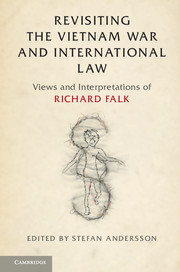Book contents
- Frontmatter
- Dedication
- Contents
- Foreword: The Harmful Legacy of Lawlessness in Vietnam
- Preface
- Acknowledgments
- PART I THE US ROLE IN VIETNAM AND INTERNATIONAL LAW
- PART II WAR AND WAR CRIMES
- 6 A ppropriating Tet
- 7 Son My: War Crimes and Individual Responsibility
- 8 The Cambodian Operation and International Law
- PART III THE VIETNAM WAR AND THE NUREMBERG PRINCIPLES
- PART IV THE LEGACY OF THE VIETNAM WAR
- Index
6 - A ppropriating Tet
from PART II - WAR AND WAR CRIMES
Published online by Cambridge University Press: 28 December 2017
- Frontmatter
- Dedication
- Contents
- Foreword: The Harmful Legacy of Lawlessness in Vietnam
- Preface
- Acknowledgments
- PART I THE US ROLE IN VIETNAM AND INTERNATIONAL LAW
- PART II WAR AND WAR CRIMES
- 6 A ppropriating Tet
- 7 Son My: War Crimes and Individual Responsibility
- 8 The Cambodian Operation and International Law
- PART III THE VIETNAM WAR AND THE NUREMBERG PRINCIPLES
- PART IV THE LEGACY OF THE VIETNAM WAR
- Index
Summary
I guess information ricochet is getting more rapid.
Tom WolfeIn Vietnam there was a war inside a country in which one side, not the other, was entirely paid, recruited, etc.
Daniel EllsbergThe Tet Offensive more than twenty years ago was, most agree, a decisive moment in the American involvement in the Vietnam War. But the interpretation of that decisiveness remains murky, obscure, contested. In this essay, my attempt is to explore Tet as a symbolic event, to describe varying interpretations of its military and political impact upon the Vietnam War, and to suggest its legacy for United States Government policy and practice with regard to armed intervention in the Third World.
POINTS OF DEPARTURE
No one has yet addressed the life history of international symbolic events that resonate in the public mind: Munich, Pearl Harbor, Yalta, Auschwitz, Hiroshima. Each name conjures up its own images. The appropriation of the name to impart a particular lesson of history can sometimes shape, even deform, public debate, as well as help establish the societal boundaries of acceptable belief. Relying on symbolic utterance to form policy in place of argument and analysis is a way of closing off the mind to the complexity of reality, including the exclusion of possibly more constructive alternative courses of action.
The Tet Offensive – or simply Tet – is one such symbolic and paradoxical event. But, unlike most of the others, its meaning remains as obscure and controverted as the war of which it was a part. Revealingly, Norman Podhoretz and Noam Chomsky, in the course of comments on the occasion of the tenth anniversary of the fall of Saigon, invoked Tet for their own contradictory reconstructions of what the Vietnam War signified. For Podhoretz, Tet was the moment when the public, Congress, and the media gave up on the war (“Only after the 1968 Tet offensive did that support begin to ebb as people felt the war was being lost, or simply not winnable”). For Chomsky, Tet is invoked not for the event itself, but as a disclosure of American reliance on unrestrained violence in the aftermath of the surprise attack upon US positions (“After the murderous post-Tet pacification campaigns and other atrocities in Laos and Cambodia”). And so it goes, to recall Vonnegut's world-weary refrain in Slaughterhouse Five.
- Type
- Chapter
- Information
- Revisiting the Vietnam War and International LawViews and Interpretations of Richard Falk, pp. 179 - 206Publisher: Cambridge University PressPrint publication year: 2017

